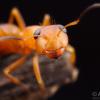Hey all,
This is a journal for a mature colony of T. sessile that I recently captured from my porch. What I am fairly certain is the entire colony had situated themselves in a pot, on a table in the full light of the sun. I took this pot indoors during quieter foraging hours, scooped its contents into a vaseline lipped container, and then went through the painstaking process of encouraging them to move into the formicarium I crafted for them. Stragglers – from both my porch and the dirt – were sifted out and aspirated, then joined with their nestmates.
The formicarium is a miniature "Kritter Keeper", cast in sanded grout (and an inconsequential quantity of perlite), and lipped in fluon. For heat, I have adhered a heat pad – designed for hermit crabs, and thus tolerant towards enclosures made of acrylic/plastic – to the side of the tank, since from poking around journal's like Crystal's I'd heard of their fondness for heat. This pad is kept on around 19 hours per day, and warms that face of the tank significantly. Incidentally, it's also where most of the colony resides, since it's dark there, too.
I plan to add an outworld soon, since they like to wander big distances. I'm also thinking of culturing pea aphids, since these ants love to tend insects, from what I've seen; I've been wondering if a lack of nutrient sources like these might be part of why they have a poor history in captivity.
The colony is pretty large, to my understanding; I have no solid estimate of their size, but think it may approach 1000, or at least the high hundreds... maybe more? No clue. They are monogynous, too ... the queen is the largest I've ever seen with respect to others I've dug up in my area, and is consistently generously distended. To give a sense of their scale, here's a timelapse of their foraging response to a weevil (or armored insect of some description, at any rate) that I chopped up and offered to them. At a later peak, this response seemed to reach ~200 individuals – though I'm pretty poor at trying to count them.
Some shots of the 4-sided enclosure, and the rest of the colony...the last one is the heated side of the tank.
And a clip of the queen herself...
Observations/Details:
I feed them everyday/every other day with the juice of whatever fresh, organic fruit I buy; these juices are offered via soaked cotton balls. They are crazy for plum juice, enjoy cantaloupe, and have also enjoyed watermelon (to a more modest degree). They'll feed on these sources for many, many hours, until nearly the entire colony have distended gasters. I also give them 24 hour access to water via the test-tube seen in the above images.
Upon capture, they had quite a big number of brood. Many of those have eclosed in the past few weeks, but the queen's chamber is ripe with eggs and early-instar larvae, so I'm hoping for a fruitful next spring...
Mortality has been minimal for these first several weeks – more from my own error (occasionally rough-housing a worker or two) than from natural causes. I'd say no more than a dozen have visibly died, including those I injured myself. Crossing my fingers. If too many do at length perish, I will release them to their own devices (which, by all accounts, seems to rebound moribund colonies quite quickly).
At the beginning, there seemed to be a few that would overcome the fluon barrier each day, but that's died down, it seems; I refreshed the coat as smoothly as possible, and don't often see any escapees. In any case, they're situated on my desk, so I'd notice if any substantial breakout began to occur.
That's all for now.. hoping for the best with this reportedly finicky species!
- WestAnts
Edited by WestAnts, August 4 2015 - 6:34 PM.

























